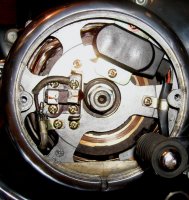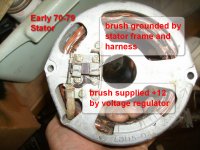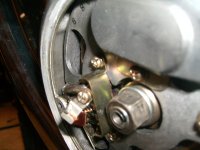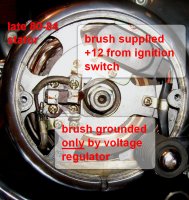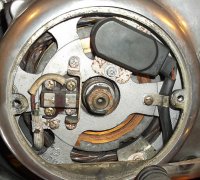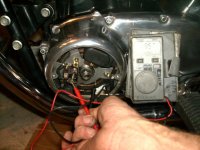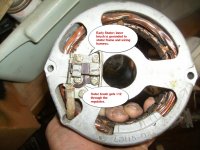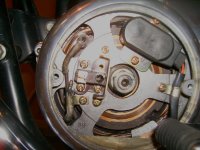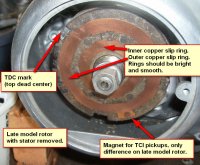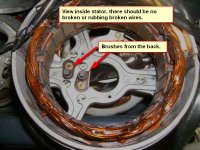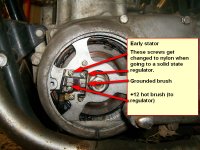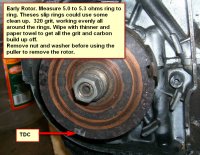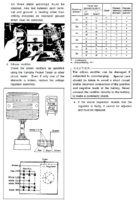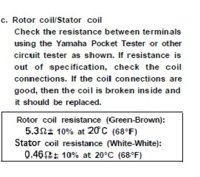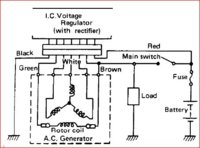Here's a start on an updated charging system guide. Let me know good bad different.
Here is the curly's guide: I have some additions, changes, pictures below
1. First charge your battery to at least 12.5-12.7V.
Is the battery Good?
Will it hold voltage overnight or longer?
Will it light a turn signal or other bulb for 15 or 20 minutes and still have 12 volts?
Is the fluid at the correct level? Use ONLY distilled water to refill if needed.
If the battery is questionable buy a new one. A too small battery can be a problem, while idling the charging system will not keep up to the load of a headlight, tail light, ignition etc and the battery will slowly discharge. Small batteries discharge faster. Yamaha calls for a 1200 RPM idle speed is to keep the battery charging, a too slow idle won't keep a battery charged.
A good charging system won't fix a bad battery, and a bad battery will break a GOOD charging system.
A VOM (Volt Ohm Meter) is needed, It doesn't have to be fancy. One can often found at the hardware store, home center, farm store, auto store, electronics store for less than $10.00 Either analog (a meter with a needle) or digital will work. The digital are easier to read and they auto range so you don't need to pick a range You just need to know what you want to measure, DC volts and Ohms are the functions we will use most. A diode test function is nice but not a "must have".
A jumper wire is nice to have. About 3 foot long, 16 gauge wire or more (14 is heavier than 16 in wire gauge) two alligator clips or a solderless lug U and an alligator clip are handy ends to have on it.
Normal hand tools. Flat and good philips screw drivers, wrenches etc. When loosening screws push firmly in, then apply torque. Do not strip the heads. Some of the screws may have been machine tightened 3 decades ago.
If you don't have one a hand impact driver is a real time and money saver.
Does my charging system work?
Start the bike, shady area is nice, point the headlight at a garage door or wall, rev the engine, does the light get brighter and then dim a bit as the engine goes back to idle? If it does you have at least SOME charging.
Stock, 1980 or later, and the headlight doesn't light at all?
You may not have any charging, the headlight is controlled by a relay that is powered directly from the stator, no charging, the relay won't close, no headlight.
2. Find a really thin feeler gauge like 0.010" or 0.015" or a wrench, steel ruler, a putty knife, or any chunk of steel that can be lightly held near the alternator cover works too, see picture) and hold it pointed down about a half inch away from your generator cover on the engine. Now turn the key on. If your regulator and rotor are working the feeler gauge should slap the case when the magnetic field is created in the rotor. If nothing happens or the magnetic effect seems really weak then go on to the next test.


3. On the solid state regulator models all you need to do is locate the green wire at the regulator plug and make a jump from it to ground. That bypasses the regulator and allows full battery current to flow through the brushes out of the rotor through the green wire to ground. That causes the rotor to make a stronger magnetic field which in turn causes more current to flow in the stator. If your battery terminal charge voltage jumps up to 14.5VDC when you rev the engine then the regulator or the ground connection for the regulator is your problem.
4. If nothing changes then it's time to check the voltage on the brown wire (It may be black on your bike) at the positive brush with the key on. It should be very close to battery voltage. The brown wire that feeds the brush gets its power from the brown wire at the keyswitch. If you don't have battery voltage at the brush then check the voltage at the switch connector while it's plugged in, by probing from the backside of the connector with the key on. Again you should see the same voltage as the battery. If you do get full battery voltage there then repair the brown wire circuit between the switch and the positive brush. If not then the switch is either bad or the red wire from the battery is not passing the full current like it should. If that's the case then keep going back along the red wire, through the main fuse until you find the source of the voltage drop. No more than 0.3 VDC drop is acceptable.
5. Once you have full voltage to the positive brush re-check the charging voltage to see if you're getting 14.5 VDC or better at the battery when revved to about 3,000 rpm. If you still don't have a charge then do the feeler gauge test again. If it slaps the case your rotor and regulator are working and you can go on to stator checks. If not then pull the brushes out of their holder and use an ohm meter to test the rotor. Measure the rotor first by touching the tester leads to the brass slip rings. Then take one lead and touch anywhere on the engine that's not painted. For the first test you should see between 5 and 5.5 ohms between the slip rings. On the second test between one slip ring and the engine you should see infinity on the meter. Any reading lower than 5 ohms on the first test or less than infinity on the second test means you have a bad rotor. Replace it. If it tests good then go on to the stator checks.
6. At the stator wire connector locate the three white wires. Use a voltmeter set on the AC scale to test the three possible connections between the white wires by probing from the backside of the connector. (The connector should be plugged together for this test) With the engine running at idle you should see about 10.5 to 11 AC volts (Not DC) on each of the three combinations of white to white that you make. If you get a very low reading on one or two legs then something is grounding your stator. If you have high readings on any of the legs (i.e. 16-18VDC) then your rectifier is bad.
7. If you got low readings on any of the stator voltage checks then unplug the connector and use your ohm meter to check the stator windings. Check the resistance between the three fabric covered wires (stator side) on the side of the connector. On each white to white connection you should read about 0.4 to 0.5 Ohms. If you get a very low reading on all of the three combinations find the single Yellow wire connector and disconnect it. Re-check your stator resistance. If the readings are now good then the yellow wire or safety relay are shorted. If there is one or more that still read low after disconnecting the yellow then check those legs by touching one lead to ground with the other on the white wire. You should see a very high Kilo ohm or infinite reading. If you get a low resistance check the stator lead pigtail to see if it is pinched by the cases or rubbed through on the frame. If that looks ok then your stator is shorted and needs to be replaced.
And that's about it except to say that dirty connections and worn brushes account for most of the charging system problems. Good Luck you'll find the problem.
Do these things first, we want to eliminate common problem areas that often cause grief on old motorcycles.
Remove clean and replace the ground strap from the battery to the frame, BOTH ends, wiggle the end connectors is there gray dust falling out, are the wires breaking or corroded looking?

If so Replace the wire. It needs to be a heavy gauge wire, all electricity from the battery has to go through this wire including the electric starter draw. Now check the red wire that goes from the + battery terminal to the starter solenoid it is heavy and about 6" long.

At the solenoid end of this big red wire a smaller red wire heads back up towards the fuse box, ALL battery current except the starter draw goes through this wire. The other big wire on a bolt next to the first wire goes to the starter. check that connection while you are here.
Basic charging test #2 you will need a wrench and a screw driver. Set them up like this. Get the wrench as close as you can to the alternator cover. turn on the ignition switch, the wrench should tap the cover and stay there. turn the switch off the wrench should fall back away. repeat if you are not sure or just think this is fun. IF the wrench moves your regulator brushes and rotor all work!

Now lets check the battery.
#1 a good a battery that is completely charged.
You want to see about 12.6 volts on your Volt ohm meter.



Here is the curly's guide: I have some additions, changes, pictures below
1. First charge your battery to at least 12.5-12.7V.
Is the battery Good?
Will it hold voltage overnight or longer?
Will it light a turn signal or other bulb for 15 or 20 minutes and still have 12 volts?
Is the fluid at the correct level? Use ONLY distilled water to refill if needed.
If the battery is questionable buy a new one. A too small battery can be a problem, while idling the charging system will not keep up to the load of a headlight, tail light, ignition etc and the battery will slowly discharge. Small batteries discharge faster. Yamaha calls for a 1200 RPM idle speed is to keep the battery charging, a too slow idle won't keep a battery charged.
A good charging system won't fix a bad battery, and a bad battery will break a GOOD charging system.
A VOM (Volt Ohm Meter) is needed, It doesn't have to be fancy. One can often found at the hardware store, home center, farm store, auto store, electronics store for less than $10.00 Either analog (a meter with a needle) or digital will work. The digital are easier to read and they auto range so you don't need to pick a range You just need to know what you want to measure, DC volts and Ohms are the functions we will use most. A diode test function is nice but not a "must have".
A jumper wire is nice to have. About 3 foot long, 16 gauge wire or more (14 is heavier than 16 in wire gauge) two alligator clips or a solderless lug U and an alligator clip are handy ends to have on it.
Normal hand tools. Flat and good philips screw drivers, wrenches etc. When loosening screws push firmly in, then apply torque. Do not strip the heads. Some of the screws may have been machine tightened 3 decades ago.
If you don't have one a hand impact driver is a real time and money saver.
Does my charging system work?
Start the bike, shady area is nice, point the headlight at a garage door or wall, rev the engine, does the light get brighter and then dim a bit as the engine goes back to idle? If it does you have at least SOME charging.
Stock, 1980 or later, and the headlight doesn't light at all?
You may not have any charging, the headlight is controlled by a relay that is powered directly from the stator, no charging, the relay won't close, no headlight.
2. Find a really thin feeler gauge like 0.010" or 0.015" or a wrench, steel ruler, a putty knife, or any chunk of steel that can be lightly held near the alternator cover works too, see picture) and hold it pointed down about a half inch away from your generator cover on the engine. Now turn the key on. If your regulator and rotor are working the feeler gauge should slap the case when the magnetic field is created in the rotor. If nothing happens or the magnetic effect seems really weak then go on to the next test.

3. On the solid state regulator models all you need to do is locate the green wire at the regulator plug and make a jump from it to ground. That bypasses the regulator and allows full battery current to flow through the brushes out of the rotor through the green wire to ground. That causes the rotor to make a stronger magnetic field which in turn causes more current to flow in the stator. If your battery terminal charge voltage jumps up to 14.5VDC when you rev the engine then the regulator or the ground connection for the regulator is your problem.
4. If nothing changes then it's time to check the voltage on the brown wire (It may be black on your bike) at the positive brush with the key on. It should be very close to battery voltage. The brown wire that feeds the brush gets its power from the brown wire at the keyswitch. If you don't have battery voltage at the brush then check the voltage at the switch connector while it's plugged in, by probing from the backside of the connector with the key on. Again you should see the same voltage as the battery. If you do get full battery voltage there then repair the brown wire circuit between the switch and the positive brush. If not then the switch is either bad or the red wire from the battery is not passing the full current like it should. If that's the case then keep going back along the red wire, through the main fuse until you find the source of the voltage drop. No more than 0.3 VDC drop is acceptable.
5. Once you have full voltage to the positive brush re-check the charging voltage to see if you're getting 14.5 VDC or better at the battery when revved to about 3,000 rpm. If you still don't have a charge then do the feeler gauge test again. If it slaps the case your rotor and regulator are working and you can go on to stator checks. If not then pull the brushes out of their holder and use an ohm meter to test the rotor. Measure the rotor first by touching the tester leads to the brass slip rings. Then take one lead and touch anywhere on the engine that's not painted. For the first test you should see between 5 and 5.5 ohms between the slip rings. On the second test between one slip ring and the engine you should see infinity on the meter. Any reading lower than 5 ohms on the first test or less than infinity on the second test means you have a bad rotor. Replace it. If it tests good then go on to the stator checks.
6. At the stator wire connector locate the three white wires. Use a voltmeter set on the AC scale to test the three possible connections between the white wires by probing from the backside of the connector. (The connector should be plugged together for this test) With the engine running at idle you should see about 10.5 to 11 AC volts (Not DC) on each of the three combinations of white to white that you make. If you get a very low reading on one or two legs then something is grounding your stator. If you have high readings on any of the legs (i.e. 16-18VDC) then your rectifier is bad.
7. If you got low readings on any of the stator voltage checks then unplug the connector and use your ohm meter to check the stator windings. Check the resistance between the three fabric covered wires (stator side) on the side of the connector. On each white to white connection you should read about 0.4 to 0.5 Ohms. If you get a very low reading on all of the three combinations find the single Yellow wire connector and disconnect it. Re-check your stator resistance. If the readings are now good then the yellow wire or safety relay are shorted. If there is one or more that still read low after disconnecting the yellow then check those legs by touching one lead to ground with the other on the white wire. You should see a very high Kilo ohm or infinite reading. If you get a low resistance check the stator lead pigtail to see if it is pinched by the cases or rubbed through on the frame. If that looks ok then your stator is shorted and needs to be replaced.
And that's about it except to say that dirty connections and worn brushes account for most of the charging system problems. Good Luck you'll find the problem.
Do these things first, we want to eliminate common problem areas that often cause grief on old motorcycles.
Remove clean and replace the ground strap from the battery to the frame, BOTH ends, wiggle the end connectors is there gray dust falling out, are the wires breaking or corroded looking?
If so Replace the wire. It needs to be a heavy gauge wire, all electricity from the battery has to go through this wire including the electric starter draw. Now check the red wire that goes from the + battery terminal to the starter solenoid it is heavy and about 6" long.
At the solenoid end of this big red wire a smaller red wire heads back up towards the fuse box, ALL battery current except the starter draw goes through this wire. The other big wire on a bolt next to the first wire goes to the starter. check that connection while you are here.
Basic charging test #2 you will need a wrench and a screw driver. Set them up like this. Get the wrench as close as you can to the alternator cover. turn on the ignition switch, the wrench should tap the cover and stay there. turn the switch off the wrench should fall back away. repeat if you are not sure or just think this is fun. IF the wrench moves your regulator brushes and rotor all work!
Now lets check the battery.
#1 a good a battery that is completely charged.
You want to see about 12.6 volts on your Volt ohm meter.
Last edited:

